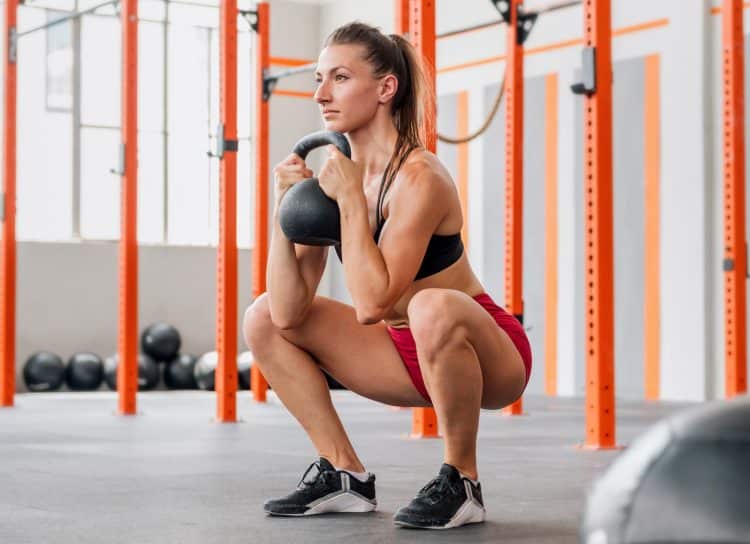Many people who lift weights also want to be lean. After all, it would be a shame to cover the results of all your hard work with a layer of obscuring blubber. Invariably, this means doing both strength training and cardio. There are numerous ways to do this, including:
- Weights followed by cardio in the same session
- Cardio followed by weights in the same session
- Cardio in the morning, weights in the evening
- Cardio in the evening, weights in the morning
- Weights one day, cardio the next
- Weights during the week, cardio at the weekends
All of these options can work, but they all share the same disadvantage – they’re very time-consuming.
Unless you are lucky enough to have endless free time or are a professional athlete who gets paid to work out, you probably have to balance your workouts with your job, home, and social life. As such, you may have to choose between working out and spending time with your friends and family.
More often than not, when time is short, workouts are usually the first casualty. After all, this is invariably something we do “for fun.”
But what if there was a way to combine cardio and strength training into the same session so you could essentially halve your workout time and frequency? Think of all the things you could be doing instead, like hanging out with your best buddies or catching up on work.
In this article, we reveal some tried-and-tested strategies for turning your weights workout into a fat-burning cardio session. Build muscle and burn fat at the same time? Darn tooting you can!
Level Up Your Fitness: Join our 💪 strong community in Fitness Volt Newsletter. Get daily inspiration, expert-backed workouts, nutrition tips, the latest in strength sports, and the support you need to reach your goals. Subscribe for free!
Shorter Rests, More Sets Per Workout
Most strength training workouts involve more time spent resting than exercising. For example, if your session calls for a not-untypical 20 sets and you spend 90 seconds resting between each one, you probably exercise for about 15 minutes but rest for 30. That’s a lot of inactivity, during which your caloric expenditure will be low.
Related: How Long Should You Rest Between Sets?
However, if you only rested 60 seconds, you could do an additional five sets or 25% more work in the same timeframe.
Needless to say, doing more work per session, which is called increasing the density of the workout, means a more significant caloric expenditure per workout. You’ll probably also experience better workout results, as the training volume will be higher.
Resting less between sets will make your workout more challenging, as you won’t be so well recovered. So, don’t slash your recovery periods too aggressively too soon. Start by shaving off ten seconds or so and whittling down the length of your rests over several weeks. This will also allow you to gradually increase your workout volume, avoiding increasing your workout volume too quickly.
Summary: Shorten your rests and use the time you save to do more sets, thus increasing workout density.
Focus on Compound Exercises
Broadly speaking, strength training exercises can be divided into two categories. Firstly, we’ve got isolation or single-joint exercises. As their name should suggest, isolation exercises involve movement at a single joint and generally use just one or two muscles at a time.
Examples of popular isolation exercises include:
- Biceps curls
- Calf raises
- Concentration curls
- Dumbbell flyes
- Hamstring curls
- Lateral raises
- Leg extensions
- Preacher curls
- Seated leg curls
- Skull crushers
- Triceps pushdowns
- Wrist curls
While all of these exercises are excellent for targeting individual muscles with laser-like precision, which can be helpful for hypertrophy, that also means that performing these exercises uses very little energy. After all, how hard are things like calf raises and wrist curls, really?
Related: Compound vs. Isolation Exercises – The Final Verdict
Conversely, movements that engage multiple joints and muscles are called compound or multi-joint exercises. With more active muscles, compound exercises use far more energy than their isolation counterparts. You’ll probably feel out of breath after a compound exercise, which is a good indicator you are working far harder.
Examples of common compound exercises include:
- Barbell squats
- Bench press
- Bent-over rows
- Clean and press
- Deadlifts
- Dips
- Lunges
- Overhead press
- Pull-ups
- Push-ups
- Romanian deadlifts
- T-bar rows
While there is nothing wrong with isolation exercises, compound exercises are better for burning calories (1). Build your workouts around compound exercises to increase your caloric expenditure per workout.
Summary: Emphasize compound exercises like squats, lat pulldowns, and overhead presses in your workouts. They burn more calories than isolation exercises like calf raises and leg curls.
Do More Full Body Workouts
There are two primary ways to organize your weekly training schedule. Split routines involve dividing your body down into separate muscle groups and training different things on different days.
For example:
| Monday | Tuesday | Wednesday | Thursday | Friday | Saturday | Sunday |
| Chest | Back | Rest | Legs | Rest | Shoulders and Arms | Rest |
In contrast, full-body workouts are just like the sound: you train all major muscle groups each time you work out, albeit typically with fewer exercises per body part. For example:
- Squats
- Bench press
- Bent-over row
- Leg curl
- Overhead press
- Lat pulldown
- Lunges
- Biceps curl
- Triceps pushdown
- Planks
Do 2-4 sets of 89-20 reps of each exercise, resting 60-90 seconds between each effort.
Both split and full-body training can be effective for all levels of exerciser. Still, full-body workouts tend to burn more calories per session (2). That’s because you use more muscle groups, leading to a greater metabolic demand and, therefore, higher caloric expenditure.
Many exercisers view full-body workouts as something beginners do before graduating to split routines. While that might be true for bodybuilders, full-body workouts are actually better for fat loss and can be every bit as advanced.
Summary: Stop training your chest on one day and your arms the next. Fat loss pros do full-body workouts to maximize their caloric expenditure.
Related: Full Body vs. Split Routines – How to Choose
Superset Everything
While reducing your inter-set rest times is a great way to increase workout density and, therefore, the caloric cost of your workouts, this strategy has limits. For example, very short rests (less than 60 seconds) will probably affect your weights and reps, potentially reducing overall workout intensity and volume. Also, studies suggest that longer rests are better for hypertrophy and strength gains (3).
One way around this problem is to use supersets in your workouts. Supersets involve doing two exercises back to back. You then rest a moment before repeating the pairing. This essentially halves the time you spend resting while still providing enough time to recover. That’s because the second exercise acts as an active rest.
For example:
- Leg press x 12 reps
- Push-ups x 20 reps
- Rest for one minute and repeat the pairing 2-3 more times
There are numerous types of supersets, but arguably the best for turning your strength training into a fat-burning workout are:
- Push-pull supersets, e.g., chest and back, quadriceps and hamstrings, etc.
- Lower body-upper body supersets. e.g., squats and pull-ups, etc.
- Agonist-opposing synergist supersets, e.g., bench press and biceps curls, etc.
These pairings ensure that the first exercise does not impair your ability to perform the second movement and vice versa.
Using supersets to reduce the time you spend resting also means you can squeeze more work into each training session, further increasing your calorie expenditure per session.
Learn more about the art and science of supersets in this in-depth guide.
Summary: Make better use of your training time with supersets. Performing exercises in pairs essentially halves the time you spend resting, so you can cram more work into each workout, burning more calories in the process.
Try Circuit Weight Training
Circuit Weight Training (CWT) is one of the most effective ways to turn a strength training session into a fat-burning workout.
What is this secret method?
Actually, it’s pretty well-known and has been around for well over 60 years. Circuit training was originally developed at Loughborough University in the United Kingdom by R.E. Morgan and G.T. Anderson as a method to optimize physical fitness and conditioning. However, as well as being a time-efficient way to build all-around fitness and strength, circuit training is also a superior fat-burning workout.
Learn more about circuit training here.
Most circuit training workouts utilize bodyweight or calisthenic exercises. However, as the name suggests, CWT involves resistance training, making it even better for building strength and muscle mass while burning calories by the truckload. This is not simple hyperbole; studies support the fat-burning, muscle-building benefits of CWT (4).
The premise of CWT is pretty simple; instead of doing several sets of an exercise and then moving on to the next, you do one set of each in turn, working through your program until you reach the end. After a short rest, you start back at the top of your list and run through the exercises again.
This has several effects:
- Less time spent resting
- Increased workout density
- Secondary cardiorespiratory effect
- Potential to do more training per session
Here’s an example circuit weight training workout to try. Do 3-5 laps of 12-20 reps of each exercise. Take no more than 15-30 seconds between movements, which should be enough time to move from one to the next. Rest 2-3 minutes between circuits.
- Goblet squat
- Dumbbell bench press
- Seated cable row
- Lunges
- Shoulder press machine
- Lat pulldown
- Romanian deadlifts
- Barbell curls
- Triceps pushdowns
- Cable crunch
Summary: Circuit Weight Training is a time-efficient and effective way to build muscle and burn fat with weights. This workout method has been around since the early 1960s, strongly suggesting it works.
Do Cardio Bursts Between Sets
There is no escaping the need for inter-set rests during strength training. As previously mentioned, most exercisers spend more time resting than they do lifting in most workouts. This significantly reduces your energy expenditure, which is why strength training has a reputation for being a less effective fat burner than cardio.
However, while rests are mainly unavoidable, there is nothing to say you have to sit and watch the clock while you recover between sets. Instead, you can use active recoveries to make better use of your time between sets.
Level Up Your Fitness: Join our 💪 strong community in Fitness Volt Newsletter. Get daily inspiration, expert-backed workouts, nutrition tips, the latest in strength sports, and the support you need to reach your goals. Subscribe for free!
In this instance, active recoveries mean doing a short burst of cardio instead of resting passively, typically 30-60 seconds.
For example, instead of doing nothing for two minutes between sets of bench presses, grab a jump rope and crank out 100 high-speed spins. Or you can hop on a bike for 60 seconds, do 25 jump jacks, 10 burpees, or a set of kettlebell swings.
While 30-60 seconds of cardio might sound too short to be beneficial, multiply that by the number of sets in your program, and you’ll quickly see how much extra movement you can add to your workout.
The trick is to choose an activity that will get you moving and raise your heart rate but won’t detract from the “meat” of your workout. For example, doing treadmill sprints between sets of squats would probably hurt your strength training performance.
You don’t have to use the same activity for your cardio bursts. You are free to mix and match options according to how you feel and the strength training exercises you are doing. Also, remember this is an active break and not a shadow workout, so don’t hammer the cardio so hard that you are out of breath and feel like you need a recovery after your recovery!
Summary: Don’t just sit and rest passively between sets of strength training. Instead, do a quick 30 to 60-second burst of cardio to increase your energy expenditure.
Add a Cardio Finisher to Your Workout
While some people prefer to do strength training and cardio separately, this is not always practical. Lifting weights one day and doing cardio the next means you may not recover fully between sessions, and you’ll need to commit to almost daily workouts.
The obvious way around this problem is to do strength and cardio in the same session. But which should you do first, especially when your goal is fat-burning?
While doing cardio before strength training means you’ll be well warmed up for lifting, it also means you may be tired and unable to lift as much weight or do as many reps as usual. In contrast, doing weights before cardio won’t harm your cardio performance too much, and studies suggest that you’ll burn more fat (5).
Strength training is predominately fueled by glycogen, which is carbohydrate stored in your muscles. The harder you train, the more glycogen is depleted. With low glycogen levels, your body has no choice but to start using more fat for fuel, so it makes sense that cardio after weights could increase fat burning.
How much post-strength training cardio should you do? That depends on your energy levels, fitness, and time available. 10-15 minutes is a good start, and 20-30 minutes should noticeably enhance fat loss.
Better yet, make the best use of your time with some interval training. Hop on an exercise bike, rower, elliptical, etc., and go flat out for 60 seconds. Recover at a leisurely pace for two minutes and repeat five times to total 15 minutes. During your two-minute recovery, take it very easy for the first 30-60 seconds, and then start accelerating gradually so that, when it’s time to start again, you are already close to your top speed.
Summary: End your strength workout with a cardio finisher to burn more fat. A short bout of 10-15 minutes should be plenty, and interval training is especially effective and time-efficient.
Don’t Go Overboard on The Post-Training Refeed
Many exercisers make their workouts less effective for fat-burning by consuming carbs and protein immediately after training. This is because of a long-held belief in something called the anabolic window.
According to anabolic window theory, your muscles are extra sensitive to the effects of insulin immediately after training, so any food consumed at this time will end up being shunted into your muscles and away from your fat stores.
While this sounds good, the reality is that the anabolic window lasts several hours, so there is no need to rush your post-training meal or worry if you don’t eat straight away (6). In addition, the post-workout anabolic window is not so powerful that you can consume vast amounts of food without gaining weight. Calories still count, even in the post-training period.
So, don’t gorge on carbs and protein immediately after training in the belief that those calories and nutrients won’t get stored as fat if they exceed your nutritional requirements; they will!
Instead, eat a small meal after training, or, better yet, don’t eat at all for a few hours to maximize the benefits of EPOC, short for post-exercise oxygen, also known as the afterburn effect.
Summary: Stop the post-training binges in the name of the anabolic window. Overeating, even immediately after a workout, will inhibit fat burning and could contribute to weight gain.
Remember: Diet Still Matters Most
All the tips in this article will help you burn more calories and fat during your strength training workouts. Most achieve this by making better use of your rest periods, so you get more work done and spend less time sitting passively waiting to start your next set. Other strategies will ensure you choose the most calorically-expensive exercises for your workouts.
However, while these strategies definitely work, their impact is still relatively small. They
will probably only increase your calorie expenditure by about 10-20% per workout. While any calorie-burning advantage is worth grabbing with both hands, it’s vital to remember that none of these interventions will offset a bad diet and calorie surplus.
The cornerstone of any effective fat-burning or weight-loss program is your diet. In fact, what you eat has such a profound effect on your body composition that you can lose or gain weight simply by manipulating your caloric balance and not changing your physical activity levels at all.
So, use these strategies, but do so in combination with a calorie deficit and healthy food choices.
Fat-Burning Strength Training – FAQs
Do you have a question about turning your strength training into a fat-burning workout or losing fat and getting lean in general? No problem, because we’ve got the answers!
1. What is the best diet for fat loss?
There are hundreds of not thousands of weight loss diets to choose from, all of which promise rapid fat loss. And while some are better than others, they all work to some degree. That’s because they all restrict your food intake, creating a calorie deficit and forcing your body to make up that energy shortfall by burning fat.
Regardless of what claims are made about any diet, they all work the same way – they involve eating less than usual.
As such, the best diet is the one you can stick to for as long as it takes to reach your body composition goal. For some, this will be keto or intermittent fasting; for others, it’ll be low-fat or liquid meal replacements.
Ultimately, there is no single best diet for fat loss. They all work if you stick with them, and they create that all-important calorie deficit. So, do your research and choose a diet you think you can maintain for as long as it takes to reach your target body composition or weight loss goal.
2. Are the methods outlined in this article suitable for beginners?
Most of the strategies outlined in this article are pretty advanced and require a reasonable fitness level to do them. As such, most beginners should focus on building a foundation with basic training methods before dialing things up and using supersets, circuits, time-restricted rest periods, etc. So, consider most of the methods outlined in this guide as intermediate/advanced.
3. What are the best times of the day to do strength training for fat loss?
This is a hotly debated topic with no clear answer. On the one hand, training in a fasted state, i.e., early morning before breakfast, may lead to faster fat loss because glycogen and blood glucose levels are lower.
In contrast, most people feel stronger and more energetic later in the day, having eaten several meals. This could lead to faster fat loss because workout intensity and duration are higher.
Ultimately, because there are pros and cons for both AM and PM training, you should try both and see which you prefer. Alternatively, just work out whenever it’s convenient, and don’t get hung up on what is actually a pretty insignificant detail.
4. Are supplements beneficial for fat loss?
Supplements can be helpful for fat loss, but none are so potent that they’ll make up for a poor diet or ineffectual workout program. Potentially beneficial fat loss supplements include:
- Fat burners
- Creatine
- Protein powder
- BCAAs and EAAs
- Green tea extract
- Cinnamon
- Low-calorie meal replacement bars and shakes
However, none of these are compulsory, and you can lose weight without supplements. Your diet and exercise program are the most critical factors.
5. How many times a week should I exercise for optimal fat loss?
There is no ideal number of workouts per week for fat loss. People have lost weight training anywhere from none to 14 times a week, i.e., twice a day. The stricter your diet, the less training you’ll need to burn fat and lose weight, as eating less will create a big enough calorie deficit.
That said, such a diet will be very strict and probably not a lot of fun. Exercising earns you a little extra dietary latitude, so you don’t have to be so exacting.
Most people should be able to lose fat with 3-5 workouts per week, combined with a moderately restrictive diet. If you feel you need to exercise more than that, you are probably paying too little attention to what you eat or enjoying a few too many cheat meals.
6. Can I target specific areas for fat loss with strength training?
Spot reduction is the idea that doing specific exercises, e.g., crunches, melts fat from the areas of your body you are training. Unfortunately, this is a myth, and spot reduction doesn’t happen.
Your body gains and loses fat globally, according to your genetics and hormonal influences. As such, you cannot preferentially burn fat from one area of your body by doing targeted exercises.
So, don’t worry about trying to lose fat from so-called problem areas. Instead, focus on losing fat from all over, and eventually, it’ll also go from the places you are most concerned with.
7. My weight has plateaued; how can I get things moving again?
Fat loss plateaus usually happen because your calorie intake is the same as your calorie expenditure. Remember, to lose weight and burn fat, you need to burn more calories than you consume to create a calorie deficit. You achieve this by eating less or exercising more. Faced with this energy shortfall, your body has no choice but to burn fat for fuel.
So, if the scales aren’t moving, you need to tighten up your diet or increase the amount of physical activity you are doing. This doesn’t necessarily mean hitting the gym longer or more often. In fact, you can increase levels of non-gym activities to get weight loss back on track, e.g., walking more, shoveling snow, cycling for transport, or playing recreational sports.
Weight loss and fat burning are always a question of energy balance, i.e., calories in vs. calories out. If your progress has stalled, creating a more significant deficit will almost always restore your progress.
Related: How to Walk for Fitness and Fat Loss
Closing Thoughts
It’s a hotly debated topic: which is better for fat loss – strength training or cardio. Common sense says it’s cardio, as the average strength training workout involves more sitting around than actual exercise. Also, cardio uses fat for fuel, whereas strength training relies more on glycogen, which is stored carbohydrate.
However, lifting weights is the way to go if you want to sculpt a muscular, aesthetically pleasing physique. Nothing builds muscle and strength like weight training.
The good news is you can “have your cake and eat it too” by using the strategies in this article to burn more calories and fat during your strength training workouts. In short, you can enjoy the fat-burning benefits of cardio without actually doing any running, cycling, stepping, etc.
However, it’s important to remember that even the most effective strategies in this article won’t make up for a poor diet or otherwise sedentary lifestyle. When it comes to losing fat and keeping it off, a holistic approach that encompasses your diet, workout plan, and lifestyle will always be more effective than a few tips and tricks.
References:
- Paoli A, Gentil P, Moro T, Marcolin G, Bianco A. Resistance Training with Single vs. Multi-joint Exercises at Equal Total Load Volume: Effects on Body Composition, Cardiorespiratory Fitness, and Muscle Strength. Front Physiol. 2017 Dec 22;8:1105. doi: 10.3389/fphys.2017.01105. PMID: 29312007; PMCID: PMC5744434.
- Evangelista AL, Braz TV, La Scala Teixeira CV, Rica RL, Alonso AC, Barbosa WA, Reis VM, Baker JS, Schoenfeld BJ, Bocalini DS, Greve JMD. Split or full-body workout routine: which is best to increase muscle strength and hypertrophy? Einstein (Sao Paulo). 2021 Aug 30;19:eAO5781. doi: 10.31744/einstein_journal/2021AO5781. PMID: 34468591; PMCID: PMC8372753.
- Schoenfeld BJ, Pope ZK, Benik FM, Hester GM, Sellers J, Nooner JL, Schnaiter JA, Bond-Williams KE, Carter AS, Ross CL, Just BL, Henselmans M, Krieger JW. Longer Interset Rest Periods Enhance Muscle Strength and Hypertrophy in Resistance-Trained Men. J Strength Cond Res. 2016 Jul;30(7):1805-12. doi: 10.1519/JSC.0000000000001272. PMID: 26605807.
- Ramos-Campo DJ, Andreu Caravaca L, Martínez-Rodríguez A, Rubio-Arias JÁ. Effects of Resistance Circuit-Based Training on Body Composition, Strength and Cardiorespiratory Fitness: A Systematic Review and Meta-Analysis. Biology (Basel). 2021 Apr 28;10(5):377. doi: 10.3390/biology10050377. PMID: 33924785; PMCID: PMC8145598.
- Margolis LM, Wilson MA, Whitney CC, Carrigan CT, Murphy NE, Hatch AM, Montain SJ, Pasiakos SM. Exercising with low muscle glycogen content increases fat oxidation and decreases endogenous, but not exogenous carbohydrate oxidation. Metabolism. 2019 Aug;97:1-8. doi: 10.1016/j.metabol.2019.05.003. Epub 2019 May 13. PMID: 31095946.
- Arent SM, Cintineo HP, McFadden BA, Chandler AJ, Arent MA. Nutrient Timing: A Garage Door of Opportunity? Nutrients. 2020 Jun 30;12(7):1948. doi: 10.3390/nu12071948. PMID: 32629950; PMCID: PMC7400240.














